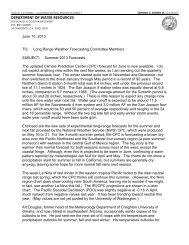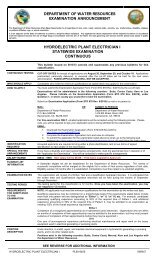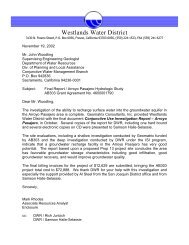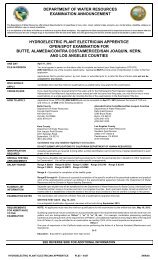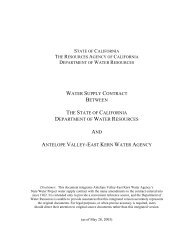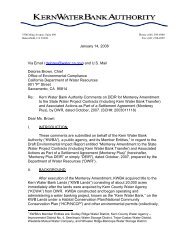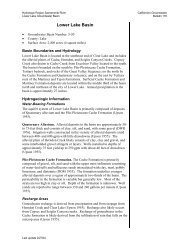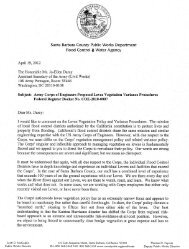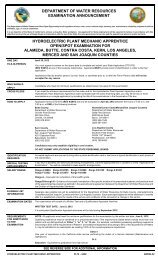Bulletin 1.pdf - California Department of Water Resources - State of ...
Bulletin 1.pdf - California Department of Water Resources - State of ...
Bulletin 1.pdf - California Department of Water Resources - State of ...
Create successful ePaper yourself
Turn your PDF publications into a flip-book with our unique Google optimized e-Paper software.
52 WATER RESOURCES OF CALIFORNIA<br />
been eliminated. However, this form <strong>of</strong> expression does not give a true<br />
measure <strong>of</strong>winter floods from drainage basins subject to substantial snow<br />
cover. Size <strong>of</strong> the area actually contributing to run<strong>of</strong>f will vary, depending<br />
upon the extent and absorptive capacity <strong>of</strong> snow cover at the time<br />
<strong>of</strong> flood. Only limited information on snow cover and its effect on rain<br />
floods is available.<br />
For streams with flow records <strong>of</strong> 20 years or longer, analyses have<br />
been made and graphs prepared for 1-, 2-, 3-, 5- and 10000y floods in<br />
drainage basins throughout <strong>California</strong> embracing areas in excess <strong>of</strong> 1,000<br />
square miles, and for all except 10-day floods in basins <strong>of</strong> less than 1,000square<br />
miles. Floods <strong>of</strong> various durations were determined on the basis<br />
<strong>of</strong> the following criteria:<br />
(1) One-day Peak Flow. This is defined as a daily flow that<br />
was both preceded and followed by lower flows. However, if two or<br />
more consecutive daily flows were equal, that flow was considered<br />
the one-day peak flow if the series <strong>of</strong> equal daily flows was both<br />
preceded and followed by lower flows.<br />
(2) Multiple - day Peak Flow. (a) Moving totals <strong>of</strong> a<br />
sequence <strong>of</strong> daily flows may be obtained by subtracting flows <strong>of</strong> the<br />
first day from the summation <strong>of</strong> flows <strong>of</strong> "n" days, and adding flow<br />
<strong>of</strong> the day succeeding the"nth" day. The largest total flow for "n"<br />
days, over a given flood period determined by such moving totals,<br />
was taken as the "n"-day peak flow <strong>of</strong> the flood.<br />
(b) If consecutive flood periods occurred with one or more days<br />
in common, only the larger flood was considered.<br />
(c) If one or more days included in a peak flow fell beyond the<br />
date arbitrarily set as the limit <strong>of</strong> the flood season, the flood was<br />
considered if the sum <strong>of</strong> daily flows within the season was greater<br />
than the sum <strong>of</strong> flows beyond the season.<br />
Flood-frequency data on rainwater floods as developed in the current<br />
investigation are presented on plates in succeeding chapters. Frequency<br />
data on volume <strong>of</strong> snow run<strong>of</strong>f, for the period from April 1st to<br />
July 31st, are presented only for the Central Valley and Lahontan Areas.<br />
QUALITY OF WATER<br />
Inorganic chemical analyses used in this bulletin for evaluating the<br />
quality <strong>of</strong> water resources were obtained from files and publications <strong>of</strong><br />
the Division <strong>of</strong> <strong>Water</strong> <strong>Resources</strong>, the United <strong>State</strong>s <strong>Department</strong> <strong>of</strong> Agriculture,<br />
the United <strong>State</strong>s Bureau <strong>of</strong> Reclamation, the United <strong>State</strong>s<br />
Geological Survey, and the University <strong>of</strong> <strong>California</strong>. Analyses <strong>of</strong> municipal<br />
supplies were also obtained from the <strong>California</strong> <strong>State</strong> <strong>Department</strong><br />
<strong>of</strong> Public Health, from United <strong>State</strong>s <strong>Department</strong> <strong>of</strong> Agriculture Technical<br />
<strong>Bulletin</strong> 448, from the City and County <strong>of</strong> San Francisco, from<br />
the City <strong>of</strong> San Diego and from the <strong>Department</strong> <strong>of</strong> <strong>Water</strong> and Power<br />
<strong>of</strong> the City <strong>of</strong> Los Angeles.<br />
Principal bases in mineral constituents <strong>of</strong> natural water solubles<br />
are calcium, magnesium, and sodium. These occur almost entirely as<br />
bicarbonates, sulphates, chlorides, and nitrates. Boron, usually present<br />
in smaller amounts than the foregoing constituents, may be particularly



